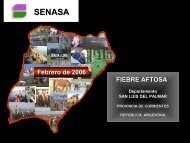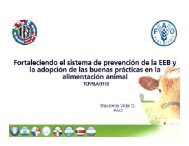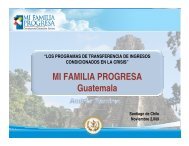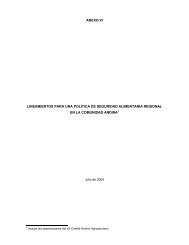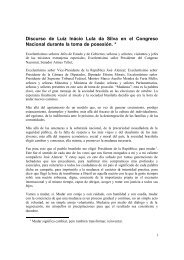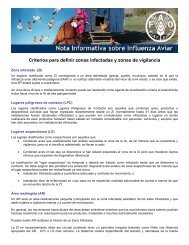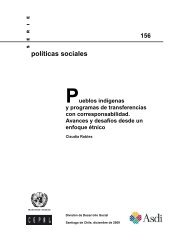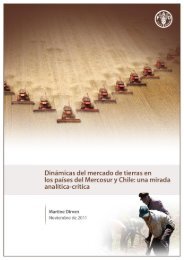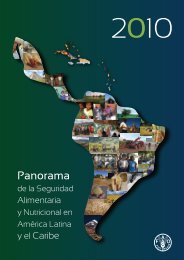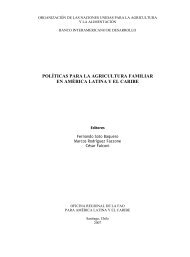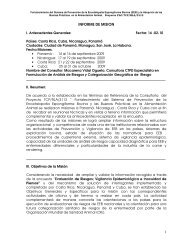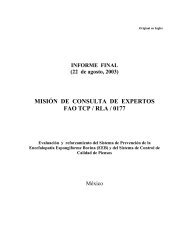enfermedad vesicular porcina - Oficina Regional de la FAO para ...
enfermedad vesicular porcina - Oficina Regional de la FAO para ...
enfermedad vesicular porcina - Oficina Regional de la FAO para ...
You also want an ePaper? Increase the reach of your titles
YUMPU automatically turns print PDFs into web optimized ePapers that Google loves.
Capítulo 2.1.3. — Enfermedad <strong>vesicu<strong>la</strong>r</strong> <strong>porcina</strong>fuertemente positivos. Los sueros que registren una media <strong>de</strong> más <strong>de</strong>l 70% <strong>de</strong> inhibición en <strong>la</strong> dilución1/7,5, pero menos <strong>de</strong>l 70% <strong>de</strong> inhibición en <strong>la</strong> dilución 1/22,5 se consi<strong>de</strong>ran débilmente positivos odudosos. Se consi<strong>de</strong>ran negativos los sueros que muestren menos <strong>de</strong>l 70% <strong>de</strong> inhibición en ambasdiluciones. Deberán confirmarse todos los resultados positivos y los dudosos utilizando <strong>la</strong> prueba <strong>de</strong>NV.SUEROS DE REFERENCIA ESTÁNDAR PARA LAS PRUEBAS SEROLÓGICAS DE LA EVPEl Laboratorio <strong>de</strong> Referencia Mundial <strong>para</strong> <strong>la</strong> Fiebre Aftosa <strong>de</strong> <strong>la</strong> <strong>FAO</strong>/OIE mantiene una serie <strong>de</strong> sueros <strong>de</strong>referencia que han sido exhaustivamente validados por los Laboratorios <strong>de</strong> Referencia Nacionales <strong>de</strong> <strong>la</strong> EVP <strong>de</strong>los Estados Miembros <strong>de</strong> <strong>la</strong> Unión Europea.C. REQUISITOS PARA LAS VACUNAS Y LOS MATERIALES DE DIAGNÓSTICOActualmente no existen vacunas disponibles comercialmente <strong>de</strong> EVP. Los sueros estándar pue<strong>de</strong>n obtenerse <strong>de</strong>lLaboratorio <strong>de</strong> Referencia Mundial <strong>para</strong> <strong>la</strong> Fiebre Aftosa <strong>de</strong> <strong>la</strong> OIE/<strong>FAO</strong> (véase nota a pie <strong>de</strong> página 1). E<strong>la</strong>nticuerpo MAb 5B7 pue<strong>de</strong> conseguirse en el Laboratorio <strong>de</strong> Referencia <strong>de</strong> <strong>la</strong> OIE <strong>para</strong> <strong>la</strong> <strong>enfermedad</strong> <strong>vesicu<strong>la</strong>r</strong><strong>porcina</strong>, que se encuentra en Italia (véase el cuadro mostrado en <strong>la</strong> Parte 3 <strong>de</strong> este Manual).REFERENCIAS1. BROCCHI E., BERLINZANI A., GAMBA D. & DE SIMONE F. (1995). Development of two novel monoclonal antibodybasedELISAs for the <strong>de</strong>tection of antibodies and the i<strong>de</strong>ntification of swine isotypes against swine <strong>vesicu<strong>la</strong>r</strong>disease virus. J. Virol. Methods, 52, 155–167.2. BROCCHI E., ZHANG G., KNOWLES N.J., WILSDEN G., MCCAWLEY J.W., MARQUARDT O., OHLINGER V.F. & DESIMONE F. (1997). Molecu<strong>la</strong>r epi<strong>de</strong>miology of recent outbreaks of swine <strong>vesicu<strong>la</strong>r</strong> disease: two geneticallyand antigenically distinct variants in Europe, 1987–1994. Epi<strong>de</strong>miol. Infect., 118, 51–61.3. CALLENS M. & DE CLERCQ K. (1999). Highly sensitive <strong>de</strong>tection of swine <strong>vesicu<strong>la</strong>r</strong> disease virus based on asingle tube RT-PCR system and DIG-ELISA <strong>de</strong>tection. J. Virol. Methods, 77, 87–99.4. DONALDSON A.I., FERRIS N.P., KNOWLES N.J. & BARNETT I.T.R. (1983). Com<strong>para</strong>tive studies of United Kingdomiso<strong>la</strong>tes of swine <strong>vesicu<strong>la</strong>r</strong> disease virus. Res. Vet. Sci., 35, 295–300.5. GOLDING S.M., HEDGER R.S., TALBOT P. & WATSON J. (1976). Radial immunodiffusion and serumneutralisation techniques for the assay of antibodies to swine <strong>vesicu<strong>la</strong>r</strong> disease. Res. Vet. Sci., 20, 142–147.6. KITCHING R.P. & DONALDSON A.I. (1987). Collection and transportation of specimens for <strong>vesicu<strong>la</strong>r</strong> virusinvestigation. Rev. sci. tech. Off. int. Epiz., 6, 263–272.7. LIN F., MACKAY D.K.J. & KNOWLES N.J. (1997). Detection of swine <strong>vesicu<strong>la</strong>r</strong> disease virus RNA by reversetranscription-polymerase chain reaction. J. Virol. Methods, 65, 111–121.8. LOXAM J.R. & HEDGER R.S. (1983). Swine <strong>vesicu<strong>la</strong>r</strong> disease: clinical signs, diagnosis, epi<strong>de</strong>miology andcontrol. Rec. sci. tech. Off. int. Epiz., 2, 11–24.9. MANN J.A. (1981). Swine <strong>vesicu<strong>la</strong>r</strong> disease. In: Virus Diseases of Farm Animals, Vol. 2, Gibbs E.P.J., ed.Aca<strong>de</strong>mic Press, London, UK, 365–381.10. NUNEZ J.I., BLANCO E., HERNANDEZ T., GOMEX-TEJEDOR C., MARTIN M.I., DOPAZO J. & SOBRINO F. (1998). A RT-PCR assay for the differential diagnosis of <strong>vesicu<strong>la</strong>r</strong> viral diseases of swine. J. Virol. Methods, 72, 227–235.11. VANGRYSPERRE W. & DE CLERCQ K. (1996). Rapid and sensitive polymerase chain reaction based on<strong>de</strong>tection and typing of foot-and-mouth disease virus in clinical samples and cell culture iso<strong>la</strong>tes, combinedwith a simultaneous differentiation with other genomically and/or symptomatically re<strong>la</strong>ted viruses. Arch.Virol., 141, 331–344.** *NB: Existen <strong>la</strong>boratorios <strong>de</strong> referencia <strong>de</strong> <strong>la</strong> OIE <strong>para</strong> <strong>la</strong> Enfermedad <strong>vesicu<strong>la</strong>r</strong> <strong>porcina</strong> (ver Cuadro en <strong>la</strong>parte 3 <strong>de</strong> este Manual <strong>de</strong> animales terrestres o consultar <strong>la</strong> página web <strong>de</strong> <strong>la</strong> OIE <strong>para</strong> una listaactualizada: www.oie.int)Manual <strong>de</strong> <strong>la</strong> OIE sobre animales terrestres 2004 155



